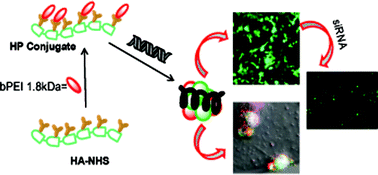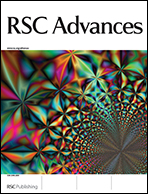Efficient DNA and siRNA delivery with biodegradable cationic hyaluronic acid conjugates†
Abstract
In the present study, biodegradable hyaluronic acid-low molecular weight branched polyethylenimine (HP) based delivery systems have been developed to address the limitations of the existing high molecular weight branched polyethylenimine (bPEI)–HA conjugates. To elucidate the influence of the degree of substitution of HA on to low molecular weight branched polyethylenimine (LMWP, 1.8 kDa), a small series of covalently linked HA–PEI (HP) conjugates was prepared by carbodiimide chemistry varying the amount of HA and the resulting conjugates were critically evaluated for their zeta potential, size, cytotoxicity and transfection efficiency. Gel retardation assay confirmed the formation of stable nanoplexes that retarded the mobility of pDNA at a conjugate to pDNA weight ratio of 1.66 [cf. 0.5 in case of bPEIs (1.8 and 25 kDa)/pDNA complexes]. MTT assay further revealed that the resulting formulations were non-toxic to cells in vitro. It was also observed that the degree of substitution of HA on to LMWP significantly affected the gene carrying capacity of the projected conjugates with one of the nanoplexes, HP2–pDNA complex, exhibited the highest transfection efficiency (∼32–38 folds as compared to LMWP) in mammalian cells. Heparin-mediated pDNA release studies showed that HP2 released >90% of bound pDNA upon exposure to 10 U of heparin. The versatility of the delivery vector, HP2, was demonstrated by delivering GFP-specific siRNA, which resulted in ∼83% suppression of the expression of the target gene (cf. ∼ 46% by Superfect™). These results advocate that hyaluronan-LMWP conjugates could be used as efficient carriers for future gene therapy applications, particularly, for targeted gene delivery to CD44 over-expressing tumors.


 Please wait while we load your content...
Please wait while we load your content...